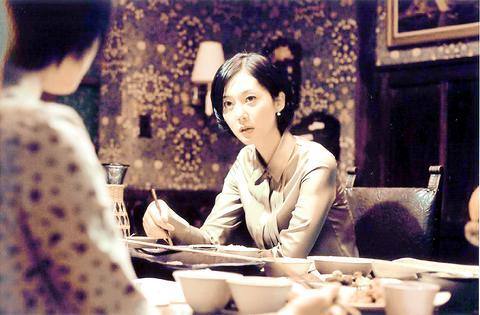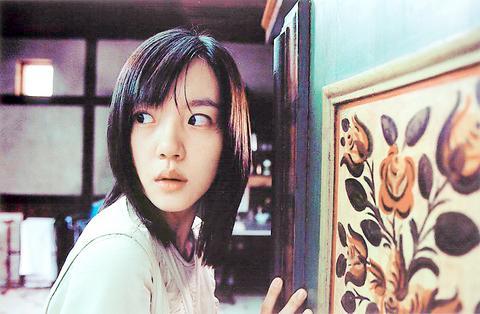Strictly speaking, A Tale of Two Sisters is more of a psycho-thriller than a horror or ghost film. After seeing the film, you cannot help but compare it with The Sixth Sense and The Others.
Director Kim Ji-woon was introduced to Taiwanese audience through his slightly violent comedy, The Foul King (2000), about a frustrated office worker who reveals a violent part of his personality through wrestling. Kim made his second appearance in Taiwan in the three-segment film Three (2002), a Korea-Thai-Hong Kong co-production. Kim directed the first segment Memory.
Those who found his previous efforts less than impressive, will be surprised by Kim's latest work, A Tale of Two Sisters.

PHOTO: FOX
Like Memory and Three, Two Sisters seeks to create a macabre and mysterious atmosphere. The narrative constantly plays mind games, and their are plenty of the usual bag of horror tricks. But this time, the story is richer and much less predictable. Even when you think you've solved the puzzle, new clues appear that entirely change the direction of the story.
Two Sisters tells the story of Su-mi (Lim Su-jeong) and Su-yeon (Mun Geun-yeong), two sisters from a rich family. After their father brings home a new partner, an icy, bewitching young woman (Yeom Jeong-ah), things at home start to go wrong. The girls' natural mother hangs herself in the big closet of the house. The older sister, Su-mi, is hospitalized as a result of excessive grief.
Back from the hospital, Su-mi starts a war against her step-mother. From acts of minor malice, the battle escalates to violence using hands, knives and boiling water. The step-mother is a former colleague of the girls' father and also used to care for their natural mother in hospital when working there as a nurse. These memories also emerge during the confrontation.

As the two sisters try to unravel the truth of their mother's death, the house becomes haunted by ghosts. Images such as floods of blood and a dead body wrapped in thick white cloth, keep rising on the screen. But you never know if these are hallucinations or real happenings. And who is the real ghost? The mother? The step-mother? Or the two sisters?
Director Kim Ji-woon has sought to differentiate his film from The Sixth Sense and The Others through new interpretations and new ways of handling the problems of the genre. "Horror films usually give key answers at the end of the film. But I tried to move ahead, revealing the answers by the middle of the film, but hopefully still keeping the audience interested until the end," Kim said.
For Kim, what is really horrifying is some memory that you want to forget but really cannot get rid off. Bad memories follow the main characters in the film like ghosts. "That is the point I wanted to make," he said.

Another plus is the eerie atmosphere created by the film's outstanding art design. The Korean title means "Roses and Lotuses," a reference to the names of the two girls. The walls of the house are decorated with complex floral patterns, which look classically graceful but also mysterious. On the other hand, the two girls wear simple, monochrome dresses. The lighting and make-up intensify the paleness of all the three women, making them both austere and fragile.
The result is a solid track record for this film. In Korea, the film sets a new box office record, taking 500 million won (US$424,126) in its first weekend. Remake rights have been purchased by DreamWorks for US$1 million.

Under pressure, President William Lai (賴清德) has enacted his first cabinet reshuffle. Whether it will be enough to staunch the bleeding remains to be seen. Cabinet members in the Executive Yuan almost always end up as sacrificial lambs, especially those appointed early in a president’s term. When presidents are under pressure, the cabinet is reshuffled. This is not unique to any party or president; this is the custom. This is the case in many democracies, especially parliamentary ones. In Taiwan, constitutionally the president presides over the heads of the five branches of government, each of which is confusingly translated as “president”

Sept. 1 to Sept. 7 In 1899, Kozaburo Hirai became the first documented Japanese to wed a Taiwanese under colonial rule. The soldier was partly motivated by the government’s policy of assimilating the Taiwanese population through intermarriage. While his friends and family disapproved and even mocked him, the marriage endured. By 1930, when his story appeared in Tales of Virtuous Deeds in Taiwan, Hirai had settled in his wife’s rural Changhua hometown, farming the land and integrating into local society. Similarly, Aiko Fujii, who married into the prominent Wufeng Lin Family (霧峰林家) in 1927, quickly learned Hoklo (commonly known as Taiwanese) and

The low voter turnout for the referendum on Aug. 23 shows that many Taiwanese are apathetic about nuclear energy, but there are long-term energy stakes involved that the public needs to grasp Taiwan faces an energy trilemma: soaring AI-driven demand, pressure to cut carbon and reliance on fragile fuel imports. But the nuclear referendum on Aug. 23 showed how little this registered with voters, many of whom neither see the long game nor grasp the stakes. Volunteer referendum worker Vivian Chen (陳薇安) put it bluntly: “I’ve seen many people asking what they’re voting for when they arrive to vote. They cast their vote without even doing any research.” Imagine Taiwanese voters invited to a poker table. The bet looked simple — yes or no — yet most never showed. More than two-thirds of those

In the run-up to the referendum on re-opening Pingtung County’s Ma-anshan Nuclear Power Plant last month, the media inundated us with explainers. A favorite factoid of the international media, endlessly recycled, was that Taiwan has no energy reserves for a blockade, thus necessitating re-opening the nuclear plants. As presented by the Chinese-language CommonWealth Magazine, it runs: “According to the US Department of Commerce International Trade Administration, 97.73 percent of Taiwan’s energy is imported, and estimates are that Taiwan has only 11 days of reserves available in the event of a blockade.” This factoid is not an outright lie — that